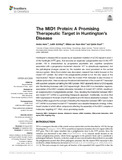Citation link:
http://dx.doi.org/10.25819/ubsi/10127Files in This Item:
| File | Description | Size | Format | |
|---|---|---|---|---|
| The_MID1_protein.pdf | 1.45 MB | Adobe PDF |  View/Open |
| Dokument Type: | Article | metadata.dc.title: | The MID1 protein: a promising therapeutic target in Huntington’s disease | Authors: | Heinz, Annika Krauß, Sybille Schilling, Judith van Roon-Mom, Willeke |
Institute: | Institut für Biologie | Free keywords: | MID1, RNA-protein interaction, CAG repeat, RNA-targeting drug | Dewey Decimal Classification: | 570 Biowissenschaften; Biologie | GHBS-Clases: | VOH VVG VYC |
Issue Date: | 2021 | Publish Date: | 2022 | Source: | Frontiers in Genetics ; 2021. - https://doi.org/10.3389/fgene.2021.761714 | Abstract: | Huntington’s disease (HD) is caused by an expansion mutation of a CAG repeat in exon 1 of the huntingtin (HTT) gene, that encodes an expanded polyglutamine tract in the HTT protein. HD is characterized by progressive psychiatric and cognitive symptoms associated with a progressive movement disorder. HTT is ubiquitously expressed, but the pathological changes caused by the mutation are most prominent in the central nervous system. Since the mutation was discovered, research has mainly focused on the mutant HTT protein. But what if the polyglutamine protein is not the only cause of the neurotoxicity? Recent studies show that the mutant RNA transcript is also involved in cellular dysfunction. Here we discuss the abnormal interaction of the mutant HTT transcript with a protein complex containing the MID1 protein. MID1 aberrantly binds to CAG repeats and this binding increases with CAG repeat length. Since MID1 is a translation regulator, association of the MID1 complex stimulates translation of mutant HTT mRNA, resulting in an overproduction of polyglutamine protein. Thus, blocking the interaction between MID1 and mutant HTT mRNA is a promising therapeutic approach. Additionally, we show that MID1 expression in the brain of both HD patients and HD mice is aberrantly increased. This finding further supports the concept of blocking the interaction between MID1 and mutant HTT mRNA to counteract mutant HTT translation as a valuable therapeutic strategy. In line, recent studies in which either compounds affecting the assembly of the MID1 complex or molecules targeting HTT RNA, show promising results. |
Description: | Finanziert aus dem Open-Access-Publikationsfonds der Universität Siegen für Zeitschriftenartikel |
DOI: | http://dx.doi.org/10.25819/ubsi/10127 | URN: | urn:nbn:de:hbz:467-22160 | URI: | https://dspace.ub.uni-siegen.de/handle/ubsi/2216 |
| Appears in Collections: | Geförderte Open-Access-Publikationen |
This item is protected by original copyright |
Page view(s)
283
checked on Nov 28, 2024
Download(s)
114
checked on Nov 28, 2024
Google ScholarTM
Check
Altmetric
Items in DSpace are protected by copyright, with all rights reserved, unless otherwise indicated.

